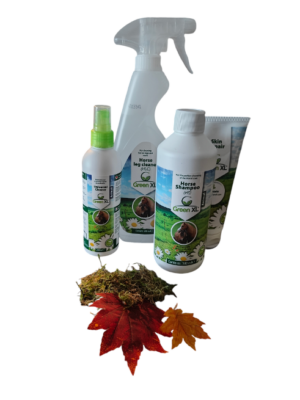Winter mite precautions
As a horse owner, you know that the winter period brings not only colder temperatures, but also an increased risk of mites on your horse. As horses create a thicker coat again in winter, it creates an ideal environment for mites to multiply. In this blog post, we discuss what exactly mites are, how to recognise them and, most importantly, what precautions you can take to prevent or treat mites on your horse in winter.
What is mite in horses?
Mite is a parasitic skin disease caused by tiny spider-like animals that live on your horse's skin. The most common species is the Chorioptes equi, also known as scabies mite. These mites dig small holes in the skin and feed on dander. This causes intense itching and irritation in the horse, which can lead to baldness, scabs and wounds from rubbing.
Mites occur mainly on the legs, especially around the pastern, and can spread to other parts of the body. Symptoms include:
- Itching and chafing, especially on the legs
- Bald spots and hair loss
- Scabs and flakes on the skin
- Thickening and rough skin
- Lameness in severe cases
Risk factors for mites in winter
Although mites can occur all year round, the risk is higher in winter due to several factors:
- Dense winter coat: The thick winter coat provides a warm and moist microclimate where mites thrive.
- Reduced resistance: Cold temperatures and less exercise can lower horses' resistance, making them more susceptible to infections.
- Close contact: In winter, horses often stand close together in stables, which facilitates the spread of mites between horses.
- Less grooming: Due to the inclement weather, owners sometimes tend to spend less time grooming their horse, which can allow mites to go undetected.
Precautions against mites
Fortunately, as a horse owner, you can take several measures to prevent or quickly treat mites:
1. Regular monitoring
Check your horse regularly for symptoms of mite, especially on the legs. Be alert for itching, bald patches and skin changes. The earlier you detect mites, the easier it is to treat.
2. Good hygiene
Provide a clean and dry environment for your horse. Change the box regularly and use clean bedding. Also clean blankets, brushes and other equipment thoroughly.
3. Coat care
Keep your horse's coat clean and free of mud and dirt. Brushing also helps to stimulate circulation and keep the skin healthy. If necessary, cut the hair around the legs a little shorter.
4. Treatment with anti-mite agents such as set from Green xl at Paardenkriebels.co.uk
There are several effective anti-mite products available, such as shampoos, sprays and ointments. Ask your vet for advice on the most suitable remedy for your horse. Follow the instructions for use carefully and treat all affected horses.
5. Quarantine and treatment of new horses
First quarantine new horses and check them for mites before letting them join your other horses. Treat infected animals immediately to prevent spreading.
6. Increase resistance
Support your horse's overall health and resistance with a balanced diet, adequate exercise and, if necessary, nutritional supplements. A healthy horse is more resistant to infections such as mites.
When to consult a vet?
Although mild cases of mites can often be remedied at home with proper care and treatment, sometimes it is necessary to consult a vet. Seek professional help if:
- Symptoms are severe or rapidly worsening
- The mite spreads over the body
- The horse becomes lame or develops other health problems
- Home treatment gives no improvement within 2-3 weeks
Your vet can confirm the diagnosis, assess the severity of the infection and prescribe stronger treatments if necessary.
Conclusion
Mite in horses is an annoying problem, especially in winter when horses have a dense coat. However, with regular monitoring, good hygiene and timely treatment, you can prevent many problems. Be alert to symptoms, take precautions and do not hesitate to ask your vet for advice when in doubt. With the right care, you will get through the winter with a healthy and mite-free horse.
Do you have any other tips to prevent or treat mites in horses in winter? Let us know in the comments below!
Disclaimer: This article is intended for informational purposes and does not replace professional veterinary advice. Always consult a qualified veterinarian to diagnose and treat health problems in your horse.